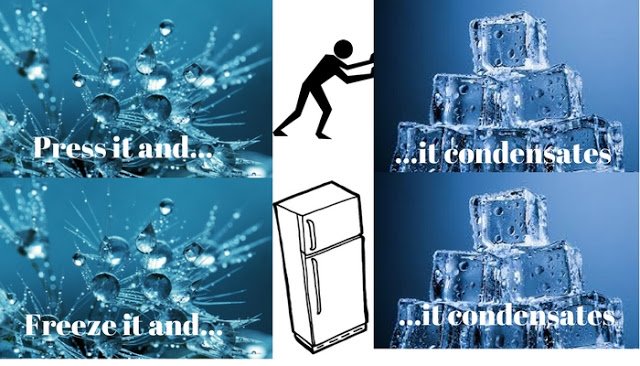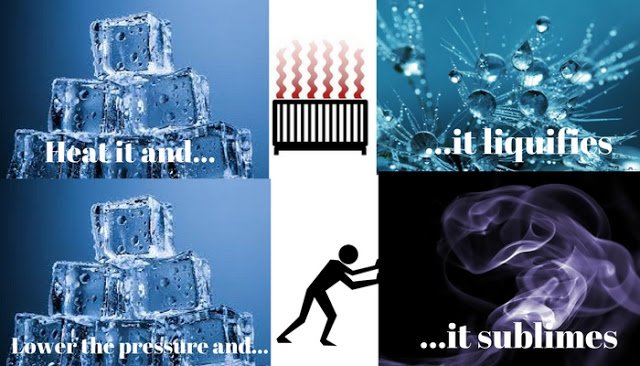Hello steemians! From the title you've already spotted the oxymoron (Woo! don't you love those greek words popping up in my english texts? Τhey make me look so clever).
How can ice be dry? It's common knowledge that ice is made from liquids...

(Original Images Under CCO License - Final Image by @ruth-girl)
This is true, but dry ice is another peculiar thing. It is ice (solid) that immediately turns to gas, skipping the liquid phase, through a process called sublimation.

(Original Images Under CCO License - Final Image by @ruth-girl)
Don't mess with my head, please! A solid becomes gas at once?
No, I'm not messing. Dry ice is basically the solid form of carbon dioxide (CO2), the gas that killed more than 1700 people in Cameroon during a limnic eruption in 1986 (remember Monday's post?) and it can be produced by CO2 gas.
Here is a CO2 profile:
- One atom of carbon bonds with two atoms of oxygen to form a molecule of CO2.
- It is colorless.
- It isn't flammable.
- It's a bad heat and electricity conductor.
- It has a very distinctive flavor.
- At pressures below 5.13 atm it sublimates. At atmospheric pressure sublimation occurs at −78.5 °C (−109.3 °F).
- It makes a great and effective cooling agent (it could give you nasty frostbites if you touch it with your bare skin).
- As it sublimates, it leaves no traces behind (what a clean little guy).
- When dissolved in water, carbonic acid (H2CO3) is formed and lowers the pH of the solution (check the video below, where they put dry ice into a pH indicator solution - 1' 50").
- It is not very toxic, but in spaces without proper ventilation it can build up in great concentrations causing hypercapnia (increased CO2 presence in your blood).
You can watch a quick presentation of dry ice in this 3-minute video:
Boring history facts:
- French Adrien-Jean-Pierre Thilorier was the first to observe this weird behavior in 1835.
- English doctor Herbert Samuel Elworthy established a patent to make liquid CO2 to mix with his whiskey in 1897 (a man loved his scotch and soda).
- In 1925 dry ice was first introduced to the market by two companies, Pest Air Devices and DryIce Corporation.
Got any recipes?
It isn't difficult to make dry ice (or cardice, another name for it). The steps are simple:
- First, you will need some CO2 gas, which you can easily attain from other rich in CO2 gases (byproducts of ammonia production, fermentation or oil refinery).
- Then, you must increase the pressure and decrease the temperature so that the gas mixture will turn to liquid.
- Next, you must lower the pressure again. At this point some liquid CO2 (almost half of it) will vaporize leading to a further drop in the temperature of the rest of the liquid (Note that the gas that escapes from the process can be either released in the atmosphere or collected to be reused in the same process). This dramatic drop in temperature will force the liquid to solidify and you'll be getting a snow-like mass.
- Finally, you must compress the snow-like mass into chunks of various sizes to suit different needs of the market. Just keep in mind that denser blocks of dry ice last longer and are easier to pack and transport.
Now, there you have it...dry ice!

(Image by: Shawn Henning - www.flickr.com)
What's it used for?
Dry ice has been widely used for industrial, commercial and scientific purposes. It has terrific cooling abilities, therefore it is used for preservation and transportation of vulnerable products (like food and medical supplies) or various processes in the lab. You can find it in fire extinguishers. There is also a cleaning method that makes use of dry ice. You can make carbonated drinks with it. Doctors use it for wart removal and it is also a great way to create that foggy effect in movies, parties, drinks and Halloween decorations. See? The list is long and it can get much longer, only I won't go any further.
There is only one I saved for an explosive ending...dry ice bombs! Yeah! You got it right! You can take advantage of the sublimation effect to create a blast using just a plastic bottle, some water and a piece of dry ice. For your safety you must try this in an open space and find a cover for any observers of the experiment. Pour some water in a bottle (fill it up to the middle), add the dry ice and put the cap on. Then, let it stand and keep your distance! There are numerous youtube videos from dry ice bombs gone wrong, I'm sure you don't want to end up one of them.
As the solid CO2 sublimates in the water (which is only used to speed up the process), the gases that are released start increasing the pressure inside the bottle. At some point the pressure gets too high and the bottle cannot hold it anymore... BOOM! The plastic bottle ends up like little Annie (-Where did little Annie go after the explosion? -Everywhere... )
Check this awesome homemade dry ice bomb:
References
wikipedia.org
science.howstuffworks.com
britannica.com
dryiceinfo.com

Thank you for reading my post! If you happen to give this experiment a try, please stay safe and make sure you still have both hands to write a comment and tell me how it worked out.
Perhaps you'd like to go through my blog, @ruth-girl, and discover plenty of educational posts along with my bizarre natural phenomena series.

Finally, the greek community of steemit is here and waiting for you to discover it! Follow the @greek-trail for daily doses of good-quality posts by wonderful writers!
Until my next post,
Steem on, people, and keep smiling!



